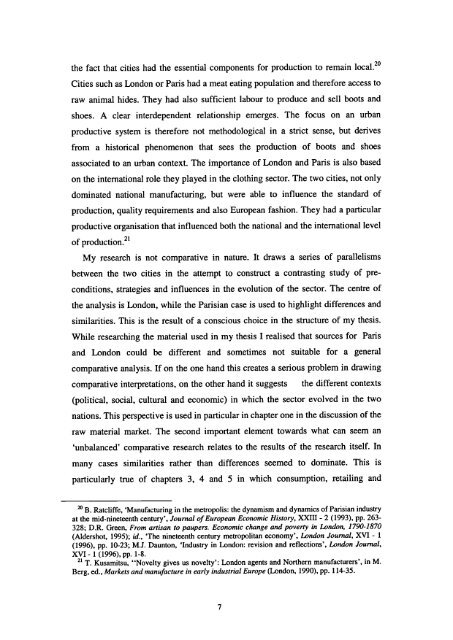The Boot and Shoe Trades in London and Paris in the Long Eighteenth Century
The Boot and Shoe Trades in London and Paris in the Long Eighteenth Century
The Boot and Shoe Trades in London and Paris in the Long Eighteenth Century
Create successful ePaper yourself
Turn your PDF publications into a flip-book with our unique Google optimized e-Paper software.
<strong>the</strong> fact that cities had <strong>the</strong> essential components for production to rema<strong>in</strong> local.20<br />
Cities such as <strong>London</strong> or <strong>Paris</strong> had a meat eat<strong>in</strong>g population <strong>and</strong> <strong>the</strong>refore access to<br />
raw animal hides. <strong>The</strong>y had also sufficient labour to produce <strong>and</strong> sell boots <strong>and</strong><br />
shoes. A clear <strong>in</strong>terdependent relationship emerges. <strong>The</strong> focus on an urban<br />
productive system is <strong>the</strong>refore not methodological <strong>in</strong> a strict sense, but derives<br />
from a historical phenomenon that sees <strong>the</strong> production of boots <strong>and</strong> shoes<br />
associated to an urban context. <strong>The</strong> importance of <strong>London</strong> <strong>and</strong> <strong>Paris</strong> is also based<br />
on <strong>the</strong> <strong>in</strong>ternational role <strong>the</strong>y played <strong>in</strong> <strong>the</strong> cloth<strong>in</strong>g sector. <strong>The</strong> two cities, not only<br />
dom<strong>in</strong>ated national manufactur<strong>in</strong>g, but were able to <strong>in</strong>fluence <strong>the</strong> st<strong>and</strong>ard of<br />
production, quality requirements <strong>and</strong> also European fashion. <strong>The</strong>y had a particular<br />
productive organisation that <strong>in</strong>fluenced both <strong>the</strong> national <strong>and</strong> <strong>the</strong> <strong>in</strong>ternational level<br />
of production.2'<br />
My research is not comparative <strong>in</strong> nature. It draws a series of parallelisms<br />
between <strong>the</strong> two cities <strong>in</strong> <strong>the</strong> attempt to construct a contrast<strong>in</strong>g study of pre-<br />
conditions, strategies <strong>and</strong> <strong>in</strong>fluences <strong>in</strong> <strong>the</strong> evolution of <strong>the</strong> sector. <strong>The</strong> centre of<br />
<strong>the</strong> analysis is <strong>London</strong>, while <strong>the</strong> <strong>Paris</strong>ian case is used to highlight differences <strong>and</strong><br />
similarities. This is <strong>the</strong> result of a conscious choice <strong>in</strong> <strong>the</strong> structure of my <strong>the</strong>sis.<br />
While research<strong>in</strong>g <strong>the</strong> material used <strong>in</strong> my <strong>the</strong>sis I realised that sources for <strong>Paris</strong><br />
<strong>and</strong> <strong>London</strong> could be different <strong>and</strong> sometimes not suitable for a general<br />
comparative analysis. If on <strong>the</strong> one h<strong>and</strong> this creates a serious problem <strong>in</strong> draw<strong>in</strong>g<br />
comparative <strong>in</strong>terpretations, on <strong>the</strong> o<strong>the</strong>r h<strong>and</strong> it suggests <strong>the</strong> different contexts<br />
(political, social, cultural <strong>and</strong> economic) <strong>in</strong> which <strong>the</strong> sector evolved <strong>in</strong> <strong>the</strong> two<br />
nations. This perspective is used <strong>in</strong> particular <strong>in</strong> chapter one <strong>in</strong> <strong>the</strong> discussion of <strong>the</strong><br />
raw material market. <strong>The</strong> second important element towards what can seem an<br />
'unbalanced' comparative research relates to <strong>the</strong> results of <strong>the</strong> research itself. In<br />
many cases similarities ra<strong>the</strong>r than differences seemed to dom<strong>in</strong>ate. This is<br />
particularly true of chapters 3, 4 <strong>and</strong> 5 <strong>in</strong> which consumption, retail<strong>in</strong>g <strong>and</strong><br />
20 B Ratcliffe, 'Manufactur<strong>in</strong>g <strong>in</strong> <strong>the</strong> metropolis: <strong>the</strong> dynamism <strong>and</strong> dynamics of <strong>Paris</strong>ian <strong>in</strong>dustry<br />
at <strong>the</strong> mid-n<strong>in</strong>eteenth century', Journal of European Economic History, XXIII - 2 (1993), pp. 263-<br />
328; D.R. Green, From artisan to paupers. Economic change <strong>and</strong> poverty <strong>in</strong> <strong>London</strong>, 1 790-1870<br />
(Aldershot, 1995); Id., '<strong>The</strong> n<strong>in</strong>eteenth century metropolitan economy', <strong>London</strong> Journal, XVI - 1<br />
(1996), pp. 10-23; Mi. Daunton, 'Industry <strong>in</strong> <strong>London</strong>: revision <strong>and</strong> reflections', <strong>London</strong> Journal,<br />
XVI - 1(1996), pp. 1-8.<br />
21 T. Kusamitsu, "Novelty gives us novelty': <strong>London</strong> agents <strong>and</strong> Nor<strong>the</strong>rn manufacturers', <strong>in</strong> M.<br />
Berg, ed., Markets <strong>and</strong> manufacture <strong>in</strong> early <strong>in</strong>dustrial Europe (<strong>London</strong>, 1990), pp. 114-35.<br />
7


